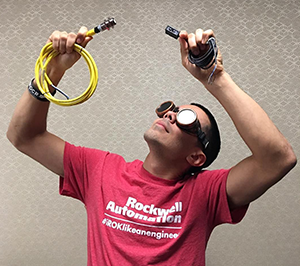It's Important to Support STEM All Year Round
Dec 06, 2017 By Jay Flores, Global STEM Ambassador, Rockwell Automation

Editor’s note: This post was previously published on LinkedIn by Jay Flores, global STEM ambassador for Rockwell Automation, a FIRST Strategic Partner.
When you were a kid sitting in class, do you remember how many times you had to hear something before you remembered it?
What I remember was not how long it took me to learn something, but how quickly I could forget it after the bell rang. Coming back after a break was brutal.
There’s a reason that happens. Research on adults in company training classes shows that within one hour, people forget an average of 50 percent of the information presented. Within 24 hours, that number rises to 70 percent, the study says. Within a week, almost 90 percent is gone.
My grandmother understood this concept well before the research confirmed her gut feeling. Some of my best memories were made during our road trips during school breaks.
I’m sitting at a tiny table in our RV, with my sister on the bench next to me, waiting for grandma to write out the math problems we’d need to complete before we could get outside. 
At the time I didn’t understand why I was doing homework on break. But now, more than 20 years later, I see her wisdom. She wanted to prevent us from losing what we’d worked so hard to learn during our school year.
Her "solve these problems, now" method worked for us – and my sister and I continued to do well in STEM (science, technology, engineering, mathematics) throughout school.
But her approach is not one that I advocate. While it maintains skills that could be lost during a long break from school, it doesn’t build or maintain what I consider even more important for success in STEM: passion.
A Better Way
STEM education is important for helping maintain a highly skilled workforce to support the sophisticated technologies of modern manufacturing. It’s essential for addressing a growing industry skills gap, as well as fostering diversity.
It’s important to keep students challenged, especially during breaks from school. Equally as important is the atmosphere. Rule one: have fun.
There are lots of engaging and fulfilling ways to enhance STEM learning when classes are not in session – and these can even supplement classroom time during the school year:
- Find STEM examples in everyday life. Create a math problem based on the movie you’re watching or the game you’re playing. Are you on vacation? Anytime kids ask “Are we there yet?” help them calculate the time left on the trip. Is your child in a sport? Have them calculate the free-throw shooting percentages or the batting averages of the players on their favorite teams. What does your child like to do for fun? There are a lot of ways to link a hobby with learning. For example, “Angry Birds” is a physics and engineering problem disguised as a game. Talk to your child about why they choose to launch the bird at a specific angle.
- Complete the Hour of Code. Kids have a blast learning code. Check out their web site for a list of ideas. They have suggestions for every age group, and activities combine online, self-paced tutorials with unplugged activities so you don’t need a computer.
- Fix things. Or at least, try to. An old clock radio, a small household appliance, an engine. Taking things apart and putting them back together requires all of the elements of STEM.
- Celebrate innovation. Find examples of exciting advancements or new applications of technology to share with your kids. Celebrate the scientists and engineers that make these advancements possible. Expose them to enough of these great role models and your child might want to grow up to be like Elon Musk.
- Enroll in a camp. There is no better way to inspire future innovators than giving them the opportunity to take a hands-on approach to solving a problem. Check out the calendars for local universities, schools, libraries and science museums – many have innovation-related camps.
Most importantly, have reasonable expectations. If you push too hard, or don’t do age-appropriate challenges, then the games become work.
Remember, this is about keeping kids energized and engaged about STEM learning, so they continue to be interested in those fields once school resumes – and hopefully, when they consider what they want to do in college and beyond.
Learn about Rockwell Automation’s four-year, $12 million commitment to FIRST to address critical need to inspire and train for today’s industrial careers.
If you have an inspiring story or piece of wisdom that you’ve picked up through your experiences in the FIRST community, please reach out to us at inspire@firstinspires.org and inquire about becoming a guest contributor for Inspire.


